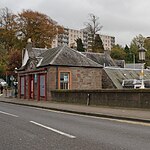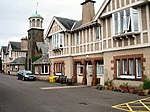Bridgend, Perth and Kinross

Bridgend is a village near Perth, Scotland, approximately 0.25 miles (0.40 km) east of the city centre, on the eastern banks of the River Tay. It is in Kinnoull parish. A settlement has existed here since at least the 16th century.The main access roads to Bridgend from the centre of Perth are West Bridge Street (the A85, which crosses Perth Bridge) and South Street (which crosses Queen's Bridge). Due to its location at the bottom of a hill rising to the east, the junction of Main Street and Gowrie Street (known as Bridgend Cross) has become prone to flooding. Torrential rains in July 2011 damaged homes and business after rivers of water flowed down Lochie Brae and Bowerswell Road. After a similar occurrence in September 2015, discussions began about installing flood defences.
Excerpt from the Wikipedia article Bridgend, Perth and Kinross (License: CC BY-SA 3.0, Authors, Images).Bridgend, Perth and Kinross
Gladstone Terrace, Perth Bridgend
Geographical coordinates (GPS) Address Nearby Places Show on map
Geographical coordinates (GPS)
| Latitude | Longitude |
|---|---|
| N 56.4001 ° | E -3.4224 ° |
Address
Gladstone Terrace
Gladstone Terrace
PH2 7DZ Perth, Bridgend
Scotland, United Kingdom
Open on Google Maps





